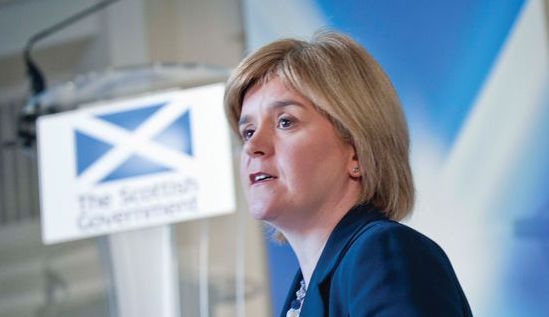
© Scottish Government/Alan Peebles
The place: a small chilly country in Northern Europe; the star: a feisty female head of government. It could be the plot of Borgen, the award-winning Danish TV drama. In fact, it is Scotland where nationalist Nicola Sturgeon, herself a devoted fan of Borgen, has been handed the keys to power.
She replaces Alex Salmond, First Minister and veteran leader of the Scottish nationalists, who stood down the day after Scotland voted ‘no’ to independence. It will be her thorny task to ensure UK government promises are kept – pledges to deliver new powers over tax and welfare for the Scottish Parliament. Even her opponents admit she is a formidable force. However, it was hardly a meteoric rise to power.
Nicola Sturgeon was born in Irvine in North Ayshire in 1970. Her father was an engineer and her mother stayed at home to look after two daughters. Sturgeon was a serious, bookish child. At the age of 16 she joined the Scottish Nationalist Party, which was no surprise as she came from a family of staunch SNP voters, including her English grandmother. Later she studied law, worked at a Glasgow law centre and tried (and failed) to win a Westminster seat for the SNP. Aged 29, she became a member of the Scottish Parliament and a protégé of Alex Salmond. Fiona Hyslop, now Scotland’s culture secretary, remembers Nicola Sturgeon as an earnest campaigner in her 20s. “She was always quite guarded, to make sure that she didn’t do or say anything that perhaps would cause difficulty later.”
The party she represented was hardly ready for power. In 2004 Alex Salmond stood down as leader of an SNP that had been torn apart by in-fighting. His replacement, John Swinney, proved unsuccessful. Was this Nicola Sturgeon’s moment? She was ready to stand for the leadership when Salmond burst back into the running and offered her the post of his deputy. After taking a few days to consider her future, she withdrew her own bid for power and accepted the Salmond ticket.
Following the SNP’s 2007 election win, she rose to become Scotland’s Deputy First Minister and Health Secretary. Catty newspaper stories spoke of a re-vamp of her image – smarter hair and power suits. By 2011 Nicola Sturgeon was at the forefront of the SNP’s landslide election victory against Scottish Labour. Some believe she had helped attract women voters who had been put off by the tribal and aggressive style of Alex Salmond, the party’s master tactician as well as her mentor and supporter. Salmond conceded that she would often rein him in by administering “a very strong corrective to my love of the cut and thrust”.
There’s no doubt she lives and breathes politics. How does she relax? In 2010 she married her long-time partner Peter Murrell, who is chief executive of the SNP. According to her mother Jean, she is a huge fan of TV’s X-Factor, but reading is her greatest love. She is able to relax, says Jean, but always with one eye on the phone. “The phone is never switched off – many of my family can vouch for that.”
Sturgeon’s biggest task yet has been to oversee the setting up of the referendum on Scottish independence. Michael Moore, who acted as Westminster’s negotiator, saw her appointment as his opposite number as a “very strong signal” that things were about to get serious.
At the 11th hour before September’s referendum, Westminster politicians who feared a ‘yes’ vote made expensive pledges about new powers for Scotland in the event of a ‘no’ vote. In the end, 55 per cent of those who voted wanted Scotland to stay within the UK. Many ‘yes’ campaigners felt devastated by the defeat. Alex Salmond decided to resign as party and government leader, taking effect last November.
There was only one candidate to replace him, quickly backed by party heavyweights. “I can think of no greater privilege than to seek to lead the party I joined when I was just 16,” she said. Now Sturgeon must deal with the post-referendum bitterness of divided families and communities, and she must ensure those hastily made UK promises become reality.
Has she given up on Scottish independence? Salmond recently warned that Scots could demand a second referendum if Westminster parties renege on their promises of further powers for Scotland’s parliament. Sturgeon has been more circumspect, saying she still believes Scotland will become independent “at some stage in the future”. The question is whether a referendum will form part of the 2016 SNP manifesto. Right now, she’s playing her cards close to her chest.
Her opponents may wholeheartedly disagree with her politics, but many concede she will be competent and pragmatic as a leader. She has certainly proved herself able to ride the turbulent wave of Scottish political history.





